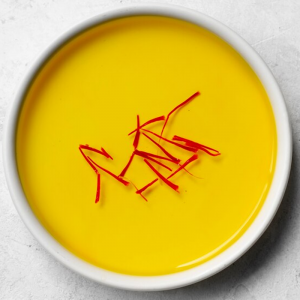Amba mango sauce Levantine specialty
الصلصة أمبا تُستخدم عادة كتوابل لإضفاء نكهة غريبة وحارة على العديد من الأطباق. يمكن أن ترافق أطباق
اللحوم، الأسماك، أو تُستخدم كغمس للوجبات الخفيفة. الصلصة أمبا لها أصول عراقية وتُقدَّر كثيرًا في المطبخ الشرق أوسطي، وخاصة في المطبخ اليهودي العراقي. غالبًا ما تُستخدم كتوابل مرافقة لأطباق مثل الفلافل، الشاورما، أو أطباق أخرى تحتوي على اللحوم، الأسماك أو الخضروات.
الصلصة أمبا تُحضَّر تقليديًا باستخدام المانجو الأخضر المخمر، لكن النسخ الحديثة غالبًا ما تستخدم المانجو الناضج لتبسيط العملية. التخمير يمنحها نكهة فريدة ومعقدة.
 Garanties sécurité
Garanties sécurité
(à modifier dans le module "Réassurance")
 Politique de livraison
Politique de livraison
(à modifier dans le module "Réassurance")
 Politique retours
Politique retours
(à modifier dans le module "Réassurance")
Mango Amba Sauce: Levantine Specialty
Amba sauce is one of the most fascinating creations of Middle Eastern cuisine, with deep roots in Iraqi culinary culture. This flavorful and spicy sauce has gradually spread to other countries in the region and is now a popular condiment throughout the Levant. Traditionally, amba sauce is used to accompany dishes like falafel, shawarma, or preparations made with meat, fish, and vegetables. Its uniqueness lies in its balance of sweetness, spices, and a slight acidity, making it a perfect addition to many types of meals.
Origins and History of Amba Sauce
The term "amba" comes from the Arabic word "مبّـا", which refers to a mango-based preparation. Although the recipe has ancient origins in Iraq, it is also closely associated with Iraqi Jewish cuisine. It was in this culture that the sauce gained popularity, especially as a condiment for street foods like falafel or shawarma. In Iraq, traditionally, amba sauce was made with fermented green mangoes to develop deeper and more complex flavors. The fermentation process added subtle acidity and richness, making this sauce a unique accompaniment. However, modern versions, although simplified, use ripe mangoes, which makes the process quicker and more accessible.
Main Ingredients of Amba Sauce
- Ripe mango: The base of this sauce is mango, which provides its natural sweetness. Ripe mangoes are typically used in the modern recipe, but green fermented mangoes give a more acidic and pronounced flavor.
- Rice vinegar: It adds a light acidic note to the sauce, balancing the sweetness of the mango. This reflects the fermentation process of the traditional version.
- Turmeric: This root gives the sauce its golden color and a warm depth of flavor. Turmeric is also known for its anti-inflammatory and antioxidant properties.
- Paprika and mustard powder: These spices add heat and depth to the sauce. Paprika can also impart a slightly smoky touch, enhancing the overall flavor.
- Chili powder: Chili (either powdered or fresh) gives the amba sauce its characteristic spiciness. The amount of chili can be adjusted to personal preference.
- Garlic: Minced garlic adds an aromatic dimension to the sauce, balancing out the other spicy flavors.
- Olive oil: It helps bind all the ingredients together, giving the sauce a smooth, creamy texture.
Detailed Recipe for Mango Amba Sauce
Ingredients:
- 1 cup of ripe mango, peeled and cut into small pieces
- 2 tablespoons of rice vinegar
- 1 tablespoon of turmeric powder
- 1 teaspoon of paprika
- 1 teaspoon of mustard powder
- 1 teaspoon of chili powder (adjust according to your spice preference)
- 2 garlic cloves, minced
- Salt to taste
- 1/4 cup of olive oil
Instructions:
- In a blender or food processor, combine the mango pieces, rice vinegar, turmeric, paprika, mustard powder, chili powder, minced garlic, and a pinch of salt.
- Blend until you achieve a smooth consistency.
- While the blender is running, slowly drizzle in the olive oil to achieve a creamy and homogenous texture.
- Taste the sauce and adjust the seasoning to your liking. You can add more salt, chili, or vinegar if desired.
- Transfer the sauce to an airtight container and refrigerate for at least an hour to allow the flavors to fully develop.
Uses for Amba Sauce
Amba sauce is extremely versatile and can be used in many ways. It pairs perfectly with meat-based dishes, such as shawarma or grilled meat skewers. It also works wonderfully with vegetarian dishes like falafel or grilled vegetables. Due to its sweet and spicy flavor, it can also be used as a dip for snacks like French fries, chips, or raw vegetables.
The Importance of Fermentation in Amba Sauce
In its traditional form, amba sauce is made with fermented green mangoes. This fermentation process gives the sauce a complexity of flavors, with a pronounced acidity that balances the sweetness of the mango. Fermentation also intensifies the sauce’s aromas and gives it a depth not found in versions that use only ripe mangoes. However, to simplify preparation and reduce cooking time, many modern recipes use ripe mangoes, making the sauce more accessible without sacrificing its sweet and spicy flavor.
Conclusion
Mango amba sauce is much more than just a condiment: it’s a culinary journey through the history and traditions of the Middle East. Its unique combination of sweetness, acidity, and spiciness makes it an essential addition to many dishes, bringing a new and exciting dimension to meals. Whether you're a fan of Middle Eastern cuisine or simply curious to try new flavors, amba sauce is a recipe you must discover and incorporate into your meals.


